
* Beginning in the 1950s, the West began to work on various concepts for jet-powered vertical take-off or landing (VTOL) combat aircraft. Of course, during those days of the Cold War, whatever the West did, the Soviets had to do as well (and the reverse), so the USSR developed a series of jet VTOL machines. This document provides a history and description of Soviet jet VTOL combat aircraft efforts.
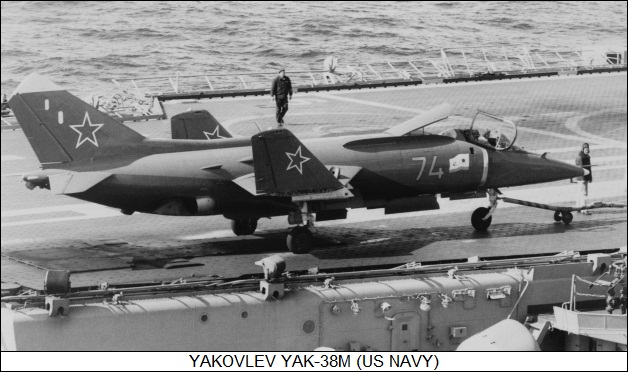
* The origins of Soviet jet VTOL remain obscure in the West. It is known that in the mid-1950s the Soviets developed their first jet VTOL platform, a test rig comparable to the British Rolls-Royce "Flying Bedstead" rig and apparently known as the "Turbolet".
Like the British Flying Bedstead, the Turbolet was a four-legged frame with a turbojet mounted vertically in the center -- in the Soviet case, a Tumanskiy RD-9BL engine, a modification of the standard engine for the Mikoyan MiG-19 fighter, with 24.53 kN (2,500 kgp / 5,510 lbf) thrust -- and four reaction thrusters or "puffers" on arms around the frame. Unlike the British machine, the Turbolet actually had an enclosed cockpit, which looked like the operator's cab of a crane. Other than the fact that the Turbolet performed its first flight in 1956 with Yuri Garnayev at the controls, not much data is available about this vehicle, or its development and test program.
However, this work clearly had some relationship to Soviet interest in "liftjets", which were small jet engines intended to be mounted vertically in aircraft to provide straight-up thrust. The Kolesov engine OKB (experimental design bureau) developed a liftjet designated the "RD-36", which provided 23.05 kN (2,350 kgp / 5,181 lbf) thrust. In 1967, the Soviets publicly displayed variants of the MiG-21, MiG-23, and Sukhoi Su-15 fighters with various combinations of Kolesov liftjets in the forward fuselage to provide short take-off or landing (STOL) performance. These STOL machines never went beyond (not very satisfactory) prototype tests; they are discussed in documents describing the relevant aircraft families. The Soviets also demonstrated a true jet VTOL aircraft in 1967, designated the "Yak-36".
During the 1960s, the British Hawker Siddeley company (later part of British Aerospace) developed a VTOL demonstrator named the Kestrel, which would lead to a production successor, the famous Harrier VTOL fighter. The Bristol company (bought out by Rolls-Royce during the decade) developed a VTOL engine named the "Pegasus" for the Kestrel. The USSR followed the development of the Kestrel and Pegasus with interest, and in 1961 the authorities had tasked the Yakovlev OKB to build a jet VTOL demonstrator, which would emerge as the Yak-36. The Tumanskiy engine design bureau was tasked with taking the R27-300 turbojet, then in development for what would become the MiG-23 fighter, and developing a non-afterburning vectored-thrust version, the "R27V-300", with two to be used to power the Yak-36.
The Yak-36 had a configuration somewhat along the lines of the Kestrel, with the engines arranged around the center of gravity of the aircraft; a set of puffers for low-speed control; and retractable bicycle landing gear (forward gear with one wheel, aft gear with two) straddling the engines, with wingtip outrigger landing gear. However, while the single-engine Kestrel had large engine intakes beside the cockpit, the twin-engine Yak-36 had the engine intakes in the nose, and there was no confusing the two aircraft: if the Kestrel was strange-looking, the Yak-36 was ugly beyond argument.
The wings were mid-mounted, short, swept, and had a distinct anhedral to allow the outrigger landing gear to reach the ground. The tail assembly was of swept tee configuration. After initial tests, twin ventral fins were fitted under the tail to improve flight stability. The two R27V-300 engines were mounted side-by-side; each provided a maximum thrust of 51.96 kN (5,300 kgp / 11,685 lbf), driven through a hydraulically-rotated "vectored-thrust" nozzle along one side and a bleed-air system for the puffers. The nozzle was rotated to provide thrust straight down for vertical flight or to the rear for horizontal flight. The side-by-side engine installation implied they had a "handed" configuration, with one engine with its nozzle on the left and the other with its nozzle on the right.
Early flights suffered from re-ingestion of exhaust gases back into the engine, and so a set of fences was installed under the aircraft to keep the exhaust gases out of the engine intakes. The twin-engine arrangement posed a flight hazard: if one engine failed, the aircraft would immediately flip over onto its back. That led to work on a system that would automatically eject the pilot if a VTOL aircraft seemed to be departing from safe vertical-flight parameters. This ejection system wasn't installed on the Yak-36, but it would be used on the Yak-36's successors.
There were four puffers: one fore and one aft for pitch control, and one in each wing for roll control. The nose puffer was in a long probe forward of the aircraft that Western observers found puzzling: some even speculated it was for ramming attacks, though that sounds like somebody just trying to be funny. Exactly how the Yak-36 performed low-speed yaw control is unclear. The rear puffer system on the Kestrel / Harrier performed both pitch and yaw control, and the Yak-36 may have used a similar scheme.
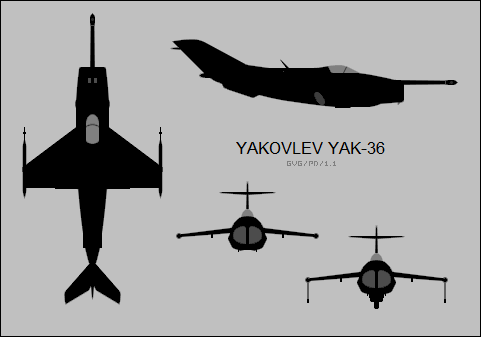
Four Yak-36s were built, with only two actually used for flight tests. Initial tethered flights were in 1963, with an initial untethered flight using a conventional take-off on 27 July 1964, and the first full VTOL flight on 24 March 1966. Yuri Garnayev performed the initial flights, though he was hospitalized after an accident in a helicopter, and most of the flights, including the first full VTOL flight, were performed by Valentin Mukhin.
___________________________________________________________________
YAKOVLEV YAK-36 FREEHAND:
___________________________________________________________________
wingspan:
10.5 meters (34 feet 5 inches)
length (with probe):
17 meters (55 feet 9 inches)
height:
4.5 meters (14 feet 9 inches)
MTO weight:
8,900 kilograms (19,625 pounds)
max speed at altitude:
1,000 KPH (620 MPH / 540 KT)
service ceiling:
12,000 meters (39,350 feet)
___________________________________________________________________
The Yak-36 was publicly displayed with justified pride in 1967, being given the NATO reporting name of "Freehand". In the public demonstrations, it carried an unguided rocket pod under each wing. In fact, although the Yak-36 had been designed with an ultimate operational use in mind, in reality its capabilities were marginal. The Kestrel was said to have a payload of a pilot with a pack of cigarettes and enough flight endurance for a drive around town, and the Yak-36 did little better. The Soviet military did not see the Yak-36 as of operational interest.
BACK_TO_TOP* The Yakovlev OKB was only getting started on the VTOL fighter concept, with bureau engineers deciding that a combination of the R27V-300 vectored-thrust engine with afterburning and Kolesov RD36-35FV liftjets had potential over the short run. The Red Navy was very interested and approved construction of prototype machines in late 1967, to be operated as strike aircraft off the KIEV-class half-deck aircraft-carrier / missile cruiser vessels then under consideration. The aircraft would also be tasked with secondary reconnaissance and interceptor roles. The prototypes were originally to be designated "Yak-36M", though in fact they were much different aircraft from the original Yak-36. The development program was actually conducted by the Red Air Force bureaucracy on behalf of the Red Navy.
Five Yak-36M prototypes were ordered, with one to be a two-seater, discussed below. Two Tu-16 "Badger" bombers were used in the test program, carrying a mockup of the Yak-36M's fuselage with engines; the fuselage was hauled below the bomb bay on a rig that allowed it to be extended into the airstream below the bomber. The first hover test flight of a single-seat Yak-36M prototype was on 22 September 1970, followed by the first conventional take-off flight on 2 December 1970. Development was troublesome, and the first full vertical take-off / horizontal flight / vertical landing flight wasn't until 25 February 1972, with Mikhail S. Deksbah at the controls. Deksbah also performed the first landing on a naval vessel, the helicopter cruiser MOSKVA, on 18 November 1972.
After working out the worst bugs, the type was ordered into manufacture, the first production item being rolled out in early 1975, with formal acceptance into Red Navy service as the "Yak-38" in October 1976. It was given the NATO reporting name of "Forger A".
The Yak-38 was a fairly sleek aircraft, arguably more so than its contemporary, the Harrier. In service, it was generally painted an overall dark sea blue. It featured:
The Tumanskiy R27V-300 main engine featured twin hydraulically-actuated vectored thrust nozzles at the rear. Max dry take-off thrust was 57.81 kN (5,895 kgp / 13,000 lbf), while afterburning thrust was 64.71 kN (6,600 kgp / 14,550 lbf). The nozzles could be moved from horizontal to vertical for landings in a single sequence that took six seconds; moving the nozzles from vertical to horizontal was done in stages, with intermediate positions at 25 and 45 degrees.
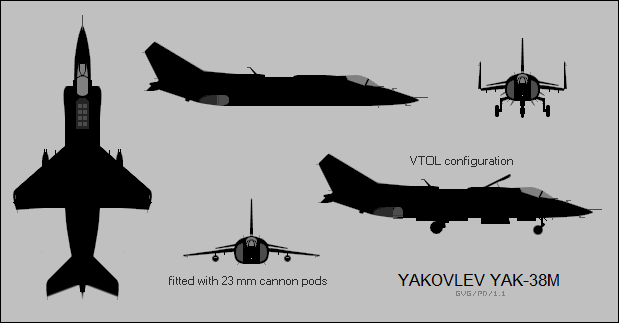
The Kolesov RD36V-35FV liftjet was a compact, lightweight unit that could provide a maximum thrust of 28.46 kN (2,900 kgp / 6,400 lbf) for a short time. The exhaust was fixed, but was "bent" to deliver thrust off the engine axis. Although both of the liftjets were installed at an angle of ten degrees to the vertical -- tilted forward so their exhaust went towards the rear -- the exhausts of the engines were at different angles so their output flow would meet under the center of gravity of the aircraft. There were ventral strakes alongside the exhausts to help maximize vertical lift.
___________________________________________________________________
YAKOVLEV YAK-38 FORGER A:
___________________________________________________________________
wingspan:
7.32 meters (24 feet)
wing area:
18.5 sq_meters (199 sq_feet)
length:
15.5 meters (50 feet 10 inches)
height:
4.4 meters (14 feet 5 inches)
empty weight:
7,484 kilograms (16,500 pounds)
MTO weight:
11,700 kilograms (25,800 pounds)
max speed at altitude:
1,050 KPH (650 MPH / 565 KT)
service ceiling:
12,000 meters (39,350 feet)
combat radius:
100 kilometers (62 MI / 55 NMI)
___________________________________________________________________
Some sources claim that the Yak-38 was fitted with a twin-barreled GSh-23L 23-millimeter cannon under the fuselage, but it does not appear to have had any built-in armament. It did have two stores pylons under each wing, for a total of four pylons, with possible stores including external tanks; dumb bombs; unguided rocket pods; cannon pods; A-60 ("AA-8 Aphid") heat-seeking air-to-air missiles (AAM); and Kh-23 ("AS-10 Karen") guided air-to-surface missiles (ASM), which demanded carriage of a guidance pod on one of the pylons. Although sources vary wildly on the Yak-38's external load capability, it appears to have been a modest 600 kilograms (1,325 pounds).
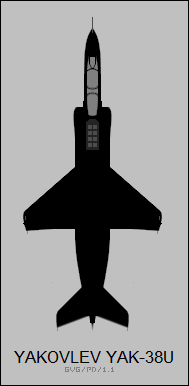
* As mentioned, one of the prototypes was a two-seater. It was recognized from the outset that flying a jet VTOL aircraft was something new, unfamiliar, and tricky, dictating development of a conversion trainer. The trainer was originally designated the "Yak-36MU", with initial (conventional take-off) flight on 17 August 1972, the pilot being Mikhail Deksbah. Introduction to service was in 1978 as the "Yak-38U"; it was given the NATO reporting name of "Forger B". The two-seat nose was basically grafted on to the single-seat fuselage at a nose-down angle to give the back-seat instructor a good forward view, with a fuselage plug inserted behind the wings to maintain pitch trim. The result was an ugly aircraft that looked much too long and bent.
* Refinements were added to the Yak-38 as the design bureau thought them up. One of the most visible was the addition of a dorsal strake along each side of the liftjet door; these two strakes helped reduce exhaust ingestion into the liftjet inlets. Boundary-layer splitter plates were also added in front of the main engine inlets. Cumulative improvements led to a generally improved variant, the "Yak-38M", with first flight in 1982.
The Yak-38M featured new, more powerful engines, in the form of the Tumanskiy R-28-300 vectored-thrust engine and the Kolesov RD-38 liftjet, both with about 10% more thrust than their predecessors. Other new kit included a steerable nosewheel, which was helpful not only for ground / deck handling but for short take-offs; a revised installation for the rear liftjet, allowing it to be rotated from 5 degrees forward to 30 degrees to the rear, probably as an aid for short take-offs; a limit setting control for the main engine exhaust nozzles, once again to support short take-offs; and an oxygen-boost system for the liftjets. There were a number of changes to improve reliability and airframe ruggedness as well.
About 150 Yak-38s of all makes were built -- the numbers vary wildly from source to source -- with the type deployed on the four KIEV-class aircraft cruiser-carrier vessels. There were experiments with operating the type off of other vessels, such as container ships rigged with flight decks, but such flights were not performed in operational service.
* Soviet-Russian design philosophy has its own style. Traditionally, at its best, Soviet-Russian gear is straightforward, effective, inexpensive, reliable, and extraordinarily rugged; at its worst, it's pathetic junk. The Yak-38 fell into the second category. Its operational radius was only about 100 kilometers (60 miles), in large part due to excessive fuel consumption in vertical flight. During cruises in tropical waters and hot weather, endurance was no more than about 15 minutes at best. As with the Harrier, Yak-38 pilots learned to prefer the short "rolling take-off" and "rolling landing" to conserve fuel, though rolling landings on carrier decks required the introduction of a safety barrier net. Apparently, the multi-engine configuration made short take-offs and landings tricky and hazardous. The limits on range-payload capability meant that the Yak-38 was usually only fitted with two stores pylons, not the full four, since it couldn't realistically carry four external stores.
Reliability was very poor. The lift engines were the worst problem, with a useful lifetime of only about 22 hours. Since the lift engines were only used in take-offs and landings that was better than it sounded, but it still wasn't good, and there were plenty of other things to go wrong. When the KIEV went on its first cruise in the Mediterranean in 1976, it carried six Yak-38s. Only three were working at the outset of the cruise, and only one was flying at the end. The unreliability was a benefit in a way, since if the aircraft didn't work, nobody had to fly them. It was tricky to pilot, and about a third of the machines would be lost in accidents through its service life.
A brief operational evaluation was performed in Afghanistan in 1980 and confirmed the limitations of the type: poor range and load, too complicated and unreliable, too hard to maintain, too hard to fly. The Afghanistan evaluation also showed that the Yak-36 kicked up tremendous clouds of dirt and dust on take-offs and landings, which could create hazards, and overall the evaluation showed that helicopter gunships were much more practical weapons, hands down.
A charitable judgement of the Yak-38 was that it was effectively an operational demonstrator machine that had been hastily pressed into service for political reasons. Although trying to second-guess bureaucratic logic is a dodgy game, certainly the Yakovlev OKB was doing everything they could to promote their VTOL technology, even if it wasn't ready for "prime time"; but it seems more likely that the Red Navy wanted aircraft carriers and could only obtain the KIEV-class vessels over the short run. To justify obtaining them, the service had to have a combat aircraft that could fly off them. It is worth noting that the KIEV-class vessels were the first warships ever operated by the Red Navy that resembled a real aircraft carrier. At least it gave the service some experience in operating carrier combat aircraft. Not all the experience was good -- but that's the way experience works.
Pilots despised the Yak-38, and were with good reason even afraid of it. Many tried to transfer to other duties, and it was not unusual for pilots to go on the sicklist rather than fly it. A handful of pilots went so far as to send a letter of complaint against the type to the Soviet Central Committee. Of course, as is often the case with bureaucracies everywhere that encounter messengers with bad news, the result was that disciplinary actions were ordered against those who had pressed the complaints.
Such actions might have reduced the complaints, but they didn't eliminate the problems. With the fall of the USSR, the Yak-38 was withdrawn from service after a crash in June 1991, with few expressing regrets over its grounding. It provides an interesting suggestion of what might have happened if some of the dodgier experimental Western VTOL combat jets developed in the 1960s had actually been put into production.
BACK_TO_TOP* Soviet-Russian design philosophy also incorporates the notion of "crawl walk run". The Yak-36 was the crawling step, the Yak-38 was the walking step; although the Yak-38 walked very poorly, the Yakovlev OKB believed they could learn from their mistakes, and move on to the running step.
The OKB began with a 1983 proposal for an improved derivative of the Yak-38M designated the "Yak-39", with the same general configuration but further refined engines; a wider-span composite wing, with flaps and leading-edge slats, along with a total of six stores pylons; and radar. It was an improvement on the Yak-38M, but not enough of one, and it was shot down before it got out of the paper stage. It was clearly only seen as an interim type, since the OKB was already working on a much better design.
In 1977, even before service introduction of the Yak-38, the go-ahead was given for development of a supersonic jet VTOL fighter, the "Yak-41". Once again, four prototypes were built, two of them being flight prototypes. Development was protracted, partly because of redefinition of the aircraft to a multirole configuration, the "Yak-41M".
Initial flight of the first machine, using a conventional take-off, was on 9 March 1987, with the chief Yakovlev test pilot, Andrei A. Sinitsyn, at the controls. The first full VTOL flight was on 13 June 1990, and the first landing on a naval vessel, the carrier-cruiser BAKU (later ADMIRAL GORSHKOV). One of the prototypes was written off after a "hard landing" accident at sea in 1991, the pilot, Vladimir Yakimov, manually ejecting safely. The Yak-41 performed impressive flight demonstrations at the Farnborough air show in the UK in 1992. The type was given the NATO reporting name of "Freestyle".
The Yak-41M was clearly a more modern and sophisticated aircraft than the Yak-38. Although some very unusual configurations were considered in early development, as the type emerged it was of very clean and sensible design. The forward fuselage resembled that of the European Tornado strike aircraft, with the slab-sided fuselage fitted with high-mounted short wings plus twin tailfins. The trapezoidal wings had a leading-edge sweep of 45 degrees and featured both leading and trailing edge flaps. The twin tail arrangement was mounted on twin booms, with the main engine exhaust nested between the booms.
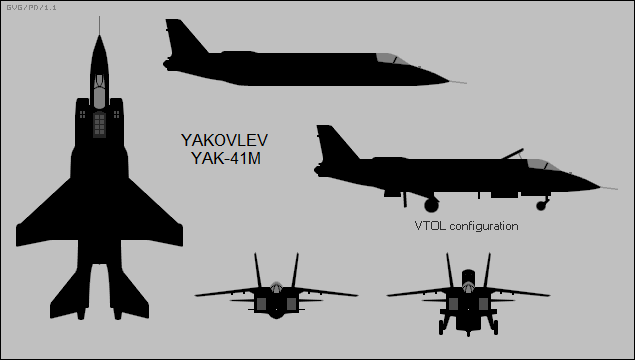
The Yak-41M was powered by a single vectored-thrust afterburning turbofan, the R-79, developed by the Kobchenko organization and with a maximum thrust of 152.0 kN (15,500 kgp / 34,170 lbf); plus twin Rybinsk (Kolesov) RD-41 liftjets in tandem behind the cockpit, each providing 40.2 kN (4,100 kgp / 9,039 lbf) thrust. The R-79 engine was fed by wedge-style inlets behind the cockpit, with four small spring-loaded relief inlets alongside and on top of each intake. The single main engine nozzle could be pivoted from vertical to horizontal and back again, and was set at 65 degrees for a short take-off. The main engine also drove a puffer system. The liftjet arrangement much like that of the Yak-38, with the two engines mounted forward and with doors top and bottom. There was a hinged panel on the belly forward of the engine exhaust that hinged down to reduce exhaust gas re-ingestion; there was also a strake on the side of the bottom of the engine nacelles that had a "flap" of sorts on front, apparently also to reduce exhaust re-ingestion.
The Yak-41M featured a tricycle landing gear arrangement along the lines of that of the Yak-38. It was armed with a built-in GSh-6-30 six-barreled Gatling-type 30-millimeter cannon, and had four underwing stores pylons, with a total stores capacity of 1,000 kilograms (2,200 pounds). That was a fairly modest warload for a strike aircraft, but its primary role was intended to be air combat, with strike as a secondary function.
___________________________________________________________________
YAKOVLEV YAK-41M FREESTYLE:
___________________________________________________________________
wingspan:
10.1 meters (33 feet 2 inches)
wing area:
31.7 sq_meters (341 sq_feet)
length:
18.3 meters (60 feet)
height:
5 meters (16 feet 5 inches)
empty weight:
11,650 kilograms (25,690 pounds)
MTO weight:
19,500 kilograms (43,000 pounds)
max speed at altitude:
1,850 KPH (1,150 MPH / 1,000 KT)
service ceiling:
15,500 meters (50,850 feet)
range:
1,400 kilometers (870 MI / 755 NMI)
___________________________________________________________________
The Yak-41M featured much more modern technology in every respect than the Yak-38. About a quarter of its empty weight was composite assemblies. It also featured an advanced avionics suite, including Zhuk Doppler radar, like that used on the MiG-29 but with a smaller antenna; a digital fire-control system linked to the radar and a helmet-mounted sight; a modernized navigation system; and a digital fly-by-wire flight control system. The flight control system performed diagnostics on the machine and would not permit take-off if a serious failure was found. It would auto-eject the pilot if a failure occurred in flight, and the main engine nozzle was 30 degrees below the horizontal.
Compared to the Yak-38, the Yak-41 could carry much more armament and fuel; it also had more efficient engines, and was designed from the outset with short take-offs in mind, giving it much better range and endurance. Although a Russian website claimed it was the "world's first supersonic VTOL aircraft", that was nonsense, since the German VJ101 and French Mirage III-V VTOL fighters had broken Mach 1 two decades earlier. However, the Yak-41 was still no slouch, setting a dozen flight records for its class. The machine was designated the "Yak-141" for the record-breaking flights -- the Soviets liked to change the designations of aircraft for establishing international records as a security measure -- and that was the designation by which it was known in the West for some time.
Unfortunately, since the Red Navy was acquiring real aircraft carriers and was obtaining carrier-based versions of the high-performance Su-27 and MiG-29 fighters, the Yak-41 was gradually eclipsed, and the entire program collapsed along with the fall of the Soviet Union. A projected two-seater, the "Yak-41UB", was never built.
How well the Yak-41 would have worked in operational service is an interesting question with no clear answer. From the looks and description of the thing, it was arguably a generation ahead of the Harrier. There are tales that Lockheed Martin consulted the Yak organization in 1995 for data to help build the VTOL version of what would become the F-35 Joint Strike Fighter.
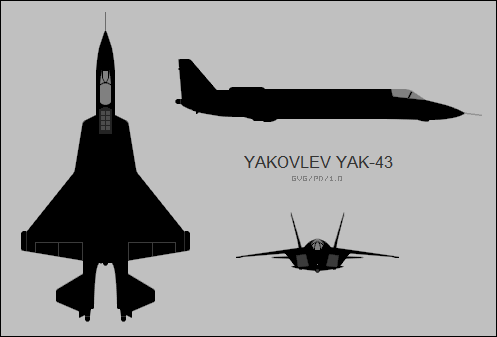
The Yakovlev organization also developed designs for an even more impressive VTOL machine, the "Yak-43", which had a configuration much like that of the Yak-41, modified with the lines of a "fourth-generation fighter" like the US F-22 Raptor. The Yak-43 would have been more agile and stealthier than the Yak-41, with longer range and more payload. Since the Yak-41M never went into production, the Yak-43 was a nonstarter -- or at least ended up on the shelf. In 2017, Russian defense officials said that investigation was underway on a new VTOL fighter, envisioned as a design descendant of the Yak-41M. There were also hints of a collaboration with China on VTOL fighters, but nothing materialized. Given the disintegration of the Russian state in the disastrous war in Ukraine in the 2020s, it is unlikely anything will happen.
BACK_TO_TOP* As is often the case in documenting Soviet-Russian aircraft, it is hard to find reliable information on Soviet VTOL aircraft. Both technical and historical details tend to vary from source to source, and even designations and simple statistical tables tend to be confused and confusing. One has to make do with what is available.

* Sources include:
* Revision history:
v1.0.0 / 01 sep 04 v1.0.1 / 01 sep 05 / Review & polish. v1.0.2 / 01 aug 07 / Review & polish. v1.0.3 / 01 jul 09 / Review & polish. v1.0.4 / 01 jun 11 / Review & polish. v1.0.5 / 01 jan 12 / Added details & artwork on Yak-43. v1.0.6 / 01 dec 13 / Review & polish. v1.0.7 / 01 nov 15 / Review & polish. v1.0.8 / 01 oct 17 / Review & polish. v1.0.9 / 01 sep 19 / Review & polish. v1.1.0 / 01 jul 21 / Review & polish. v1.1.1 / 01 jun 23 / Review & polish. v1.1.2 / 01 jun 25 / Review & polish. (*)BACK_TO_TOP
